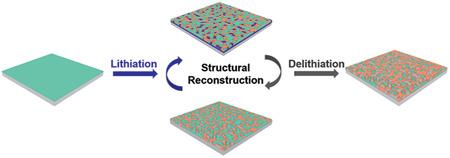当前位置:
X-MOL 学术
›
Adv. Mater.
›
论文详情
Our official English website, www.x-mol.net, welcomes your
feedback! (Note: you will need to create a separate account there.)
Stabilization of Sn Anode through Structural Reconstruction of a Cu-Sn Intermetallic Coating Layer.
Advanced Materials ( IF 27.4 ) Pub Date : 2020-08-25 , DOI: 10.1002/adma.202003684 Guanzhi Wang 1, 2 , Megan Aubin 2, 3 , Abhishek Mehta 2, 3 , Huajun Tian 1 , Jinfa Chang 1 , Akihiro Kushima 1, 2, 3 , Yongho Sohn 2, 3 , Yang Yang 1, 2, 4
Advanced Materials ( IF 27.4 ) Pub Date : 2020-08-25 , DOI: 10.1002/adma.202003684 Guanzhi Wang 1, 2 , Megan Aubin 2, 3 , Abhishek Mehta 2, 3 , Huajun Tian 1 , Jinfa Chang 1 , Akihiro Kushima 1, 2, 3 , Yongho Sohn 2, 3 , Yang Yang 1, 2, 4
Affiliation

|
The metallic tin (Sn) anode is a promising candidate for next‐generation lithium‐ion batteries (LIBs) due to its high theoretical capacity and electrical conductivity. However, Sn suffers from severe mechanical degradation caused by large volume changes during lithiation/delithiation, which leads to a rapid capacity decay for LIBs application. Herein, a Cu–Sn (e.g., Cu3Sn) intermetallic coating layer (ICL) is rationally designed to stabilize Sn through a structural reconstruction mechanism. The low activity of the Cu–Sn ICL against lithiation/delithiation enables the gradual separation of the metallic Cu phase from the Cu–Sn ICL, which provides a regulatable and appropriate distribution of Cu to buffer volume change of Sn anode. Concurrently, the homogeneous distribution of the separated Sn together with Cu promotes uniform lithiation/delithiation, mitigating the internal stress. In addition, the residual rigid Cu–Sn intermetallic shows terrific mechanical integrity that resists the plastic deformation during the lithiation/delithiation. As a result, the Sn anode enhanced by the Cu–Sn ICL shows a significant improvement in cycling stability with a dramatically reduced capacity decay rate of 0.03% per cycle for 1000 cycles. The structural reconstruction mechanism in this work shines a light on new materials and structural design that can stabilize high‐performance and high‐volume‐change electrodes for rechargeable batteries and beyond.
中文翻译:

通过铜-锡金属间镀层的结构重建来稳定锡阳极。
金属锡(Sn)阳极具有很高的理论容量和导电性,因此是下一代锂离子电池(LIB)的有希望的候选者。然而,锡由于在锂化/脱锂期间的大体积变化而导致严重的机械劣化,这导致LIB应用的容量快速下降。此处,Cu–Sn(例如,Cu 3Sn)金属间涂层(ICL)经过合理设计,可通过结构重建机制稳定Sn。Cu-Sn ICL对锂化/脱锂的低活性使金属Cu相与Cu-Sn ICL逐渐分离,从而提供可调节且适当的Cu分布以缓冲Sn阳极的体积变化。同时,分离的Sn与Cu的均匀分布促进了均匀的锂化/去锂化,从而减轻了内部应力。另外,残余的刚性的Cu-Sn金属间化合物显示出极好的机械完整性,可抵抗锂化/脱锂过程中的塑性变形。结果,通过Cu-Sn ICL增强的Sn阳极显示出循环稳定性的显着改善,容量衰减率为0。1000次循环,每个循环03%。这项工作中的结构重建机制为新材料和结构设计提供了亮点,它们可以稳定可充电电池及其以外的高性能和大容量更换电极。
更新日期:2020-10-20
中文翻译:

通过铜-锡金属间镀层的结构重建来稳定锡阳极。
金属锡(Sn)阳极具有很高的理论容量和导电性,因此是下一代锂离子电池(LIB)的有希望的候选者。然而,锡由于在锂化/脱锂期间的大体积变化而导致严重的机械劣化,这导致LIB应用的容量快速下降。此处,Cu–Sn(例如,Cu 3Sn)金属间涂层(ICL)经过合理设计,可通过结构重建机制稳定Sn。Cu-Sn ICL对锂化/脱锂的低活性使金属Cu相与Cu-Sn ICL逐渐分离,从而提供可调节且适当的Cu分布以缓冲Sn阳极的体积变化。同时,分离的Sn与Cu的均匀分布促进了均匀的锂化/去锂化,从而减轻了内部应力。另外,残余的刚性的Cu-Sn金属间化合物显示出极好的机械完整性,可抵抗锂化/脱锂过程中的塑性变形。结果,通过Cu-Sn ICL增强的Sn阳极显示出循环稳定性的显着改善,容量衰减率为0。1000次循环,每个循环03%。这项工作中的结构重建机制为新材料和结构设计提供了亮点,它们可以稳定可充电电池及其以外的高性能和大容量更换电极。









































 京公网安备 11010802027423号
京公网安备 11010802027423号